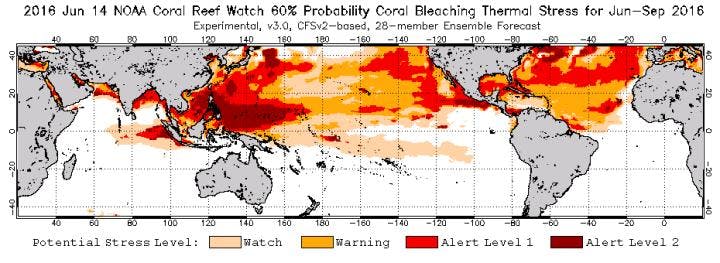The global coral reef bleaching crisis is about to get worse.
The catastrophic event that began in mid-2014 is likely to continue this year, scientists from the the US National Ocean and Atmospheric Association (NOAA) warn. This is because sea temperatures will remain higher-than-normal for an “unprecedented” third consecutive year, they say.
Coral reefs in the U.S. will be hit especially hard, according to NOAA. Reefs in Hawaii, Guam, the Commonwealth of the Northern Mariana Islands, Florida Keys, U.S. Virgin Islands and Puerto Rico are at the greatest risk of mass bleaching, they say.
The agency predicts that there is 75 per cent chance of a La Nina developing this year, which can cause ocean temperatures in Western Pacific to shoot up. Once La Nina conditions set in, NOAA’s models show that coral reefs in the Pacific island nations of Palau and the Federated States of Micronesia have a 90 per cent likelihood of widespread coral bleaching.

NOAA Coral Reef Watch satellite data shows continued bleaching through September 2016. Image courtesy of NOAA.
Rising sea temperatures — even one or two degrees Celsius higher than the seasonal average — can cause corals to expel the colorful algae that live in their tissues in a mutual arrangement. Once the algae are gone, the corals turn pale or ghostly white. Sometimes, the bleached corals can recover. But prolonged hotter-than-normal sea temperatures can reduce their chances of recovery considerably, leading to their death.
The ongoing bleaching event has already extensively damaged and injured coral reefs in the U.S.
“
It’s time to shift this conversation to what can be done to conserve these amazing organisms in the face of this unprecedented global bleaching event.
Jennifer Koss, Coral Reef Conservation Program director, NOAA
Scientists from the University of Queensland in Australia who recently surveyed four sites in Hawaii — Big Island, Maui, Molokai and Lanai — were shocked by what they saw.
“One hundred to two hundred-year-old colonies of the lobe coral and almost all of the Cauliflower coral gardens that dominated the reefs we visited 11 months ago were gone, with only one or two small colonies remaining,”Manuel Gonzalez-Rivero, expedition leader and UQ Global Change Institute scientist, said in a statement.
Australia’s Great Barrier Reef has suffered widespread bleaching too, as have coral reefs in the Indian Ocean.
“It’s time to shift this conversation to what can be done to conserve these amazing organisms in the face of this unprecedented global bleaching event,” Jennifer Koss, NOAA’s Coral Reef Conservation Program director, said. “We have boots on the ground and fins in the water to reduce local stressors. Local conservation buys us time, but it isn’t enough. Globally, we need to better understand what actions we all can take to combat the effects of climate change.”
This story was published with permission from Mongabay.










